American Crow: Everything You Should Know
Updated: Apr. 04, 2024
American crow, we love you so! Learn important facts about crows, including where they live, what they eat, and what their calls sound like.
On This Page
What Does an American Crow Look Like?
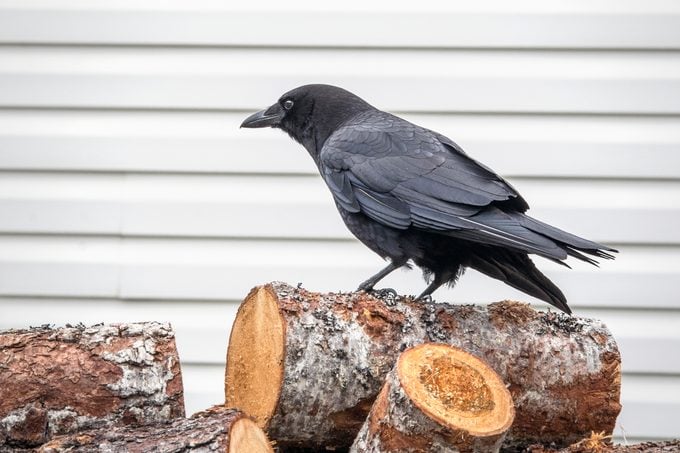
It’s pretty much impossible to miss an American crow (Corvus brachyrhynchos). These large, completely black birds in the corvid family tend to travel in flocks ranging from a handful of birds into the hundreds of thousands. Crows can measure up to 20 inches from their large, thick beak to their tail, and they can weigh as much as 20 ounces.
It’s nearly impossible to tell male and female crows apart. The only way to differentiate between them is if they’re sitting close—then, a slight difference in size might be noticeable. Males are generally larger than females.
Here’s how to tell the difference between similar-looking ravens and crows.
Crow Nests and Eggs
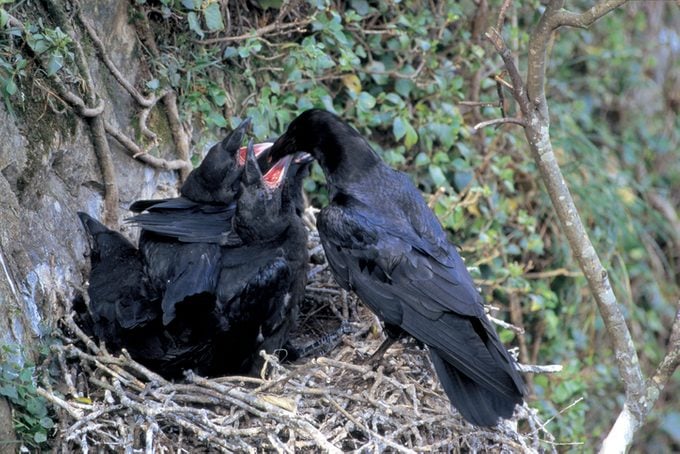
Typically American crows build their nests high off the ground. Both halves of a mated pair help in its construction; young from previous broods may also pitch in. Nests are usually made from twigs, and a soft lining rests on the inside.
Crow eggs are usually approximately 2 inches in length and 1 inch in width. They can be blue-green or green in color, with brownish spots.
Psst—baby crows are much cuter than you think.
American Crow Call and Sounds
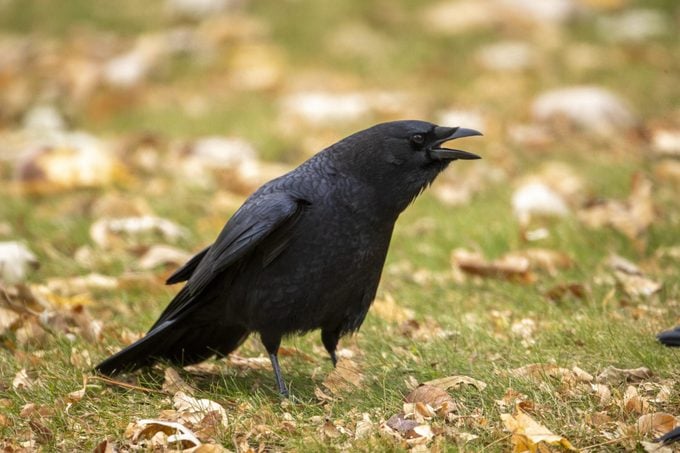
The crow’s typical vocalization is no secret: a harsh, loud caw-caw-caw. That’s hardly their only noise, though. American crows, like the rest of their corvid family members, can make a variety of sounds which include rattling croaks, gurgles and snapping their beaks.
Bird sounds courtesy of the Cornell Lab of Ornithology
If you’ve ever wondered, this is why crows chase hawks.
What Do American Crows Eat?
Some might say crows are the raccoons of the bird world. They’ll chow down on pretty much anything, including stomach-churning stuff. You might’ve heard rumors that crows eat carrion, and those rumors are true. They’ll also munch on garbage… and the eggs or young of other birds.
Before you clutch your pearls, take note that they’re hardly the only species to do this. Some jays, herons and woodpeckers rob nests, too!
Crows will swoop in to snag insects, snakes or fish, and they’ll eat fruits and vegetables, too.
Meet the fish crow: the American crow’s coastal cousin.
Do Crows Visit Bird Feeders?
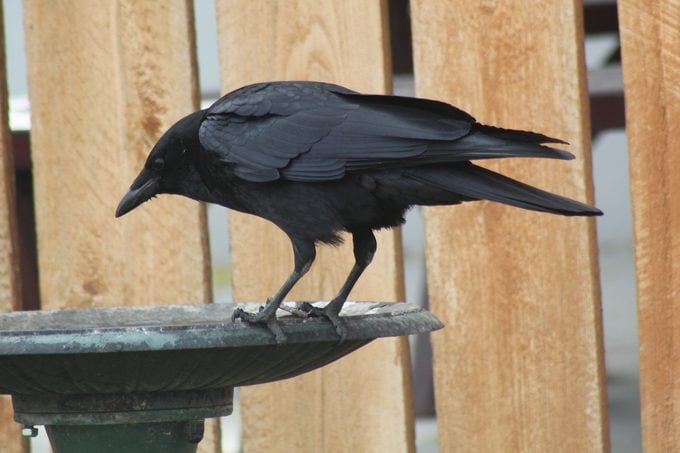
Crows don’t typically eat birdseed that’d draw in your favorite songbirds like cardinals and goldfinches. They tend to root around for their food, which makes them a rare sight at backyard feeders. (Also rare: spotting an albino crow.) You’re more likely to see grackles and blackbirds, instead.
With that said, crows, like their blue jay relatives, do enjoy eating peanuts. By putting out a platform feeder packed with peanuts in or out of the shell, you might be able to draw them in. You can try a ground feeder as well, since they like to dine on the ground. As with many birds that don’t come to feeders, it’s possible to attract American crows with a bird bath.
If you see a crow at your backyard feeding station, look closely and you might spot some usual bird behavior.
“A few American crows visit my platform feeder for shelled peanuts. Instead of eating the peanuts right away, the crows take them over to the birdbath, dunk them in the water, then eat them. Why do they do that?” asks Birds & Blooms reader Sandy Hannemann of Mequon, Wisconsin.
Birding experts Kenn and Kimberly Kaufman explain, “Although it’s rare for most birds to dunk their food, this odd habit has been observed many times in grackles and crows. No one knows why they do this. Dunking might soften certain foods but wouldn’t affect hard items like peanuts. It’s not to clean their food either, since they sometimes dip clean food into muddy water.
Some have suggested that crows get food wet to take moisture back to their nestlings, but they dunk food even in seasons when they’re not feeding young. So the behavior remains a fascinating mystery.”
Learn how to identify Steller’s jays: clever black and blue birds.
What Is a Group of Crows Called?
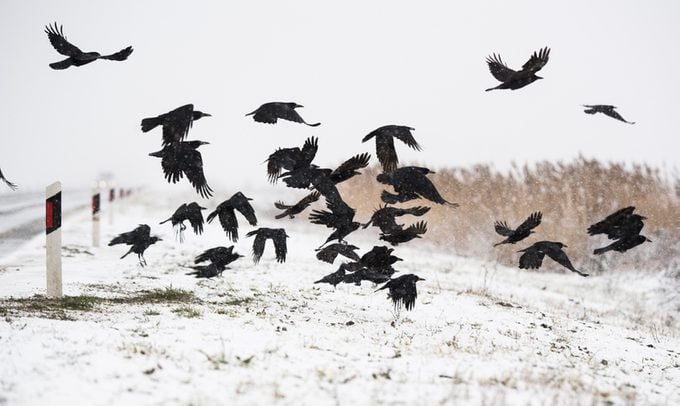
While there exists a wide variety of amusing names for groups of birds—a “parliament” of owls, for example—you’re not soon to forget the name for a gathering of crows. Referred to collectively as a “murder,” the name ties back to ancient superstitions that cast crows as an omen of impending death or destruction.
However, there’s no reason to be scared of their bad reputation. Keep in mind that crows and other corvids are considered some of the smartest birds, too.
Here’s what it means if you see a crow.
American Crow Range and Habitat
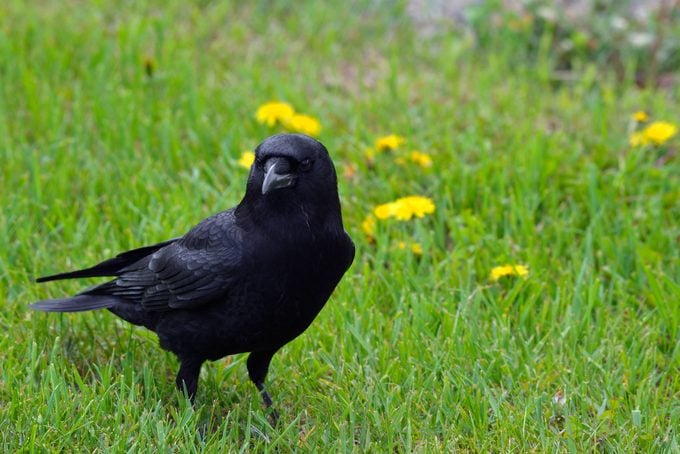
There’s no need to fret about saving up for a special birding trip to spot an American crow. If you’re in the U.S., chances are decent that they’re already flying around your neighborhood. These birds adapted well to city living, so they’re as at home among skyscrapers and in suburbs as in groves of trees.
Their year-round range stretches through most of the United States with the exception of a few northernmost Midwest states and Canada, where they only spend the breeding season.
Next, learn interesting facts about common ravens.
Sources
- Cornell Lab of Ornithology – All About Birds
- National Audubon Society
- Merriam-Webster dictionary
- Nature – PBS.org
About the Experts
Kenn and Kimberly Kaufman are the official birding experts for Birds & Blooms. They are the creators of the Kaufman Field Guide series and they speak and lead birding trips all over the world.
Why Trust Us
For nearly 30 years, Birds & Blooms, a Trusted Media Brand, has been inspiring readers to have a lifelong love of birding, gardening and nature. We are the #1 bird and garden magazine in North America and a trusted online resource for over 15 million outdoor enthusiasts annually. Our library of thousands of informative articles and how-tos has been written by trusted journalists and fact-checked by bird and garden experts for accuracy. In addition to our staff of experienced gardeners and bird-watchers, we hire individuals who have years of education and hands-on experience with birding, bird feeding, gardening, butterflies, bugs and more. Learn more about Birds & Blooms, our field editor program, and our submission guidelines.




















